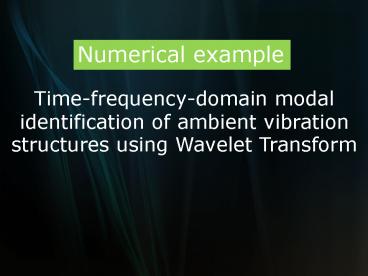Time-frequency-domain modal identification of ambient vibration structures using Wavelet Transform - PowerPoint PPT Presentation
Title:
Time-frequency-domain modal identification of ambient vibration structures using Wavelet Transform
Description:
Time-frequency-domain modal identification of ambient vibration structures ... fy : Central wavelet frequency Wavelet function The complex Morlet wavelet is ... – PowerPoint PPT presentation
Number of Views:158
Avg rating:3.0/5.0
Title: Time-frequency-domain modal identification of ambient vibration structures using Wavelet Transform
1
Time-frequency-domain modal identification of
ambient vibration structures using Wavelet
Transform
Numerical example
2
Natural frequency damping
Damping Ratios Identification
Natural Frequencies Identification
Frequency domain
Time domain
Cutting slide
Frequency
Time
3
Wavelet transform
- Continuous wavelet transform (CWT) is defined as
convolution operator of signal X(t) and wavelet
function
Wavelet function
Complex conjugate of wavelet function
Wavelet transform coefficient
Wavelet scale and translation parameters
- Info of time and frequency can be obtained.
Relation of - wavelet scale and Fourier frequency can be
estimated
s Wavelet scale fF Fourier frequency
fs Sampling frequency fy Central wavelet
frequency
4
Wavelet function
- The complex Morlet wavelet is commonly used in
the CWT
Fourier transform of complex Morlet wavelet
Fourier frequency and central wavelet frequency
5
Damping mode shapes
- Output displacements of the MDOF system can be
- decomposed in the structural normalized
coordinates
- Wavelet transform coefficient of output
response
- Mode shape can be estimated via the wavelet
coefficients - of output displacements at point k and
reference point
- Decay envelope and logarithmic decrement can be
- extracted from this decay envelope and in tern
of modulus
and
6
Damped natural frequencies
Wavelet transform (Floor1)
Frequency domain
t80s
14.02Hz
9.12Hz
5.91Hz
Wavelet transform (Floor5)
Frequency domain
t80s
- Difficulties in identifying high-order
low-dominant frequencnies - due to inflexible resolutions used
smoothing
7
Refined by bandwidth filtering
- Filtered at frequency bandwidths
- 1) 0-3.125Hz
- 2) 3.125-6.25Hz
- 3) 6.25-12.5Hz
- 4) 12.5-25Hz
- 5) 25-50Hz
8
Refined wavelet transform
Bandwidth 0-20Hz
Bandwidth 0-3.125Hz
Dominant for mode 1
f11.72Hz
Only 1st mode dominated
Bandwidth 3.125-6.25Hz
f25.37Hz
Dominant for mode 2
- Refined and localized by
- multiresolution analysis
- Filtered at frequency
- bandwidths
- (0-3.125Hz 3.125-6.25Hz
- 6.25-12.5Hz 12.5-25Hz
- 25-50Hz)
Bandwidth 6.25-12.5Hz
Dominant for mode 3
f38.99Hz
9
Refined wavelet transform
Bandwidth 0-3.125Hz
Mode 1
Amplitude envelope slop
1.76Hz
Slide 1
Slide 2
f11.72Hz
Damped Natural Frequencies (Hz) Damped Natural Frequencies (Hz) Damped Natural Frequencies (Hz) Damped Natural Frequencies (Hz)
FEM FDD FDD-RDT WT
mode 1 1.69 1.73 1.73 1.76
mode 2 5.22 5.35 5.34 5.47
mode 3 9.26 8.84 8.82 8.95
mode 4 13.6 13.69 13.67 13.72
mode 5 17.8 18.05 18.02 18.14
Mode 2
Bandwidth 3.125-6.25Hz
5.49Hz
Slide 1
Slide 2
f25.37Hz
Bandwidth 6.25-12.5Hz
Mode 3
Slide 1
Slide 2
8.95Hz
f38.99Hz































